Unit: AM/FM Stereo Receiver
Manufacturer: Pioneer
Model: SX-950
SN: XH2906404S
Today I'm showcasing a Pioneer SX-950 vintage receiver that came in for restoration. The SX-950 is a high-end offering from Pioneer's most famous product line, the SX-X50 series. It was initially introduced in 1976 and made through 1978. It delivers a continuous power output of 85 watts per channel into an 8 ohms load from 20 to 20 kHz with no more than 0.1% total harmonic distortion.
The SX-950 looks very similar to SX-850 which I serviced a few months ago. The only difference is the number of speaker terminals. The SX-950 has three speaker terminals (A, B, and C) while the SX-850 has only two (A and B). Both units have the same dimensions and similar weight. Moreover, all boards except the tuner and power amplifier assembly have the same circuit design.
According to the Pioneer database, this particular unit was manufactured in August 1977.
The restoration of the smaller brothers of SX-950 can be found on my blog here:
Initial Evaluation and Troubleshooting
The protection relay in this unit was bypassed for some reason. Obviously, this is not a smart decision and should be fixed. Moreover, the previous owner (or whoever serviced this receiver before) added two additional capacitors (6800uF/71V) parallel to the main filter capacitors (22000uF/63V). Again, not a good idea. I know some technicians like the idea to upgrade the main filter capacitors with higher capacitance but I am not in favor of this modification. It potentially can increase the stress on the circuit and reduce the overall reliability. I always prefer to stick with the original circuit design.
Also, look at the photos below. Did you notice how badly this modification was done?! Check this out: a lot of extra soldering alloy was used, the insulating sleeve on both original filter capacitors was touched with a soldering iron and melted, the insulation on some wires was also melted, and the electrical tape was used instead of shrink tubing. It's sloppy work! Well, everything should be reworked here to bring it back to its original configuration.
Protection relay bypassed, wire insulation was melted, electrical tape was used instead of shrink tubing
Two additional capacitors (6800uF/71V) were added (not a good idea and sloppy work)
I removed the original protection relay and checked its contacts. To my surprise, all contacts were still in perfect condition. I didn't notice any degradation due to arcing. I also tested the power supply and protection unit and didn't find any substantial issues. So, not sure why the protection relay in this unit was bypassed.
I replaced the original relay with a new Omron relay (part # LY2F-DC24) and wired it according to the schematic. Then, I powered up this receiver with my Dim Bulb Tester. The light bulb flashed for a second on bright and then dimmed out almost completely. The protection relay engaged after a few seconds and a normal sound was restored. So, the unit works properly again.
A new Omron protection relay was installed
After discussion with the owner, it was decided to remove additional capacitors and restore the original circuit. The original filter capacitors (22000uF/63V) were tested with Atlas ESR70 capacitance meter and are still within the factory capacitance tolerance with almost zero ESR: 18100uF/0.01Ω and 18230uF/0.01Ω. So, I rewired them and also installed new metal oxide resistors (KOA Speer, 2.7kΩ/2W). All wires with melted insulation were also replaced. The electrical tape was replaced with shrink tubing. Now, it's time to move to routine restoration.
Original (22000uF/63V) filter capacitors - rewired
Power Supply Board (AWR-101)
The power supply board (AWR-101) has twelve aluminum electrolytic capacitors C10 thru C16, C18 thru C21, and C23. All of them were replaced with low impedance and high-reliability Nichicon UPW/UPM caps. The max operating voltage was increased one step up on several e-caps.
The original e-caps removed from this board were tested with an Atlas ESR70 capacitance meter and the results are below. Only two out of twelve original e-caps are outside the factory capacitance tolerance +/- 20%. Not too bad in comparison to the SX-850 which I serviced a few months ago.
Test results on original capacitors removed from power supply board:
C10: rated capacitance – 470uF, measured – 370uF, ESR – 0.02Ω, deviation: -21%
C11: rated capacitance – 470uF, measured – 399uF, ESR – 0.02Ω, deviation: -15%
C12: rated capacitance – 2200uF, measured – 2120uF, ESR – 0.01Ω, deviation: -4%
C13: rated capacitance – 1000uF, measured – 1072uF, ESR – 0.01Ω, deviation: +7%
C14: rated capacitance – 47uF, measured – 53uF, ESR – 0.38Ω, deviation: +13%
C15: rated capacitance – 470uF, measured – 374uF, ESR – 0.01Ω, deviation: -20%
C16: rated capacitance – 47uF, measured – 51uF, ESR – 0.71Ω, deviation: +9%
C18: rated capacitance – 47uF, measured – 34uF, ESR – 2.6Ω, deviation: -28%
C19: rated capacitance – 47uF, measured – 56uF, ESR - 0.24Ω, deviation: +19%
C20: rated capacitance – 100uF, measured – 101uF, ESR – 0.06Ω, deviation: +1%
C21: rated capacitance – 47uF, measured – 52uF, ESR – 0.78Ω, deviation: +11%
C23: rated capacitance – 100uF, measured – 114uF, ESR - 0.16Ω, deviation: +14%
All transistors on this board were also replaced to improve the reliability of the power supply. They should be retired after working hard for the last 45+ years. Below is a list of original and replacement transistors I used. Four transistors Q1, Q2, Q8, and Q9 are mounted on the heat sink. The old thermal pads were replaced with new Mica ones. The old thermal compound was refreshed with a new silicone thermal compound (Wakefield-Vette, 120 series).
Q1: NPN, 2SD313 (original), replaced with a new Fairchild KSC2073TU
Q2: PNP, 2SB507 (original), replaced with a new Fairchild KSA940TU
Q3: NPN, 2SC1384 (original), replaced with a new Fairchild KSC2383YTA
Q4: PNP, 2SA720 (original), replaced with a new Fairchild KSA1013YBU
Q5: NPN, 2SC1384 (original), replaced with a new Fairchild KSC2690AYSTU
Q6: PNP, 2SA720 (original), replaced with a new Fairchild KSA1013YBU
Q7: NPN, 2SC1384 (original), replaced with a new Fairchild KSC2383YTA
Q8: NPN, 2SD313 (original), replaced with a new Fairchild KSC2073TU
Q9: NPN, 2SD313 (original), replaced with a new Fairchild KSD526Y
Q10: NPN, 2SC869 (original), replaced with a new Fairchild KSC2383YTA
Power supply board - before servicing
Power supply board - after servicing
Protection Unit (AWM-062-0)
The protection unit in Pioneer SX-950 (as well as in SX-850) has the same design as in Pioneer SX-1010 introduced to the market in 1974. There are two coupling capacitors (C1, C2) and four aluminum electrolytic capacitors (C3 thru C6) installed on this board. Two coupling capacitors are the notorious sky blue Sanyo e-caps. I replaced them with high-quality film polyester Kemet caps. The remaining aluminum e-caps were replaced with low impedance Nichicon UPW caps.
Test results on original capacitors removed from protection unit board:
C1: rated capacitance – 0.22uF, measured – 0.28uF, ESR – N/A, deviation: +27%
C2: rated capacitance – 0.22uF, measured – 0.28uF, ESR – N/A, deviation: +27%
C3: rated capacitance – 330uF, measured – 354uF, ESR – 0.21Ω, deviation: +7%
C4: rated capacitance – 330uF, measured – 305uF, ESR – 0.19Ω, deviation: -8%
C5: rated capacitance – 4.7uF, measured – 5.3uF, ESR – 1.57Ω, deviation: +13%
C6: rated capacitance – 100uF, measured – 114uF, ESR – 0.21Ω, deviation: +14%
The relay driver transistor Q7 suffers from the current spike every time the relay turns off. Eventually, it fails due to severe degradation. I unsoldered and tested this transistor with Atlas DCA55 semiconductor analyzer. The measured current gain was only 57. According to the datasheet, the minimum gain for this transistor is supposed to be at least 120 (2SC1384, rank R). I replaced the original 2SC1384 transistor with a new Fairchild KSC2690. The new transistor has the same pinout as the original one. Also, a fly-back safety diode (1N4004G) was added to the circuit to prevent potential output damage. The safety diode was soldered between pins 9 (anode, "+") and 10 (cathode, "-").
Protection unit - before and after
Tone Amplifier Board (AWG-039C)
The tone amplifier board installed in this unit is AWG-039, revision C. Note that two electrolytic capacitors (C29 & C30) are bypassed in revision C. The tone amplifier board has two solid tantalum capacitors (C25, C26), eight low leakage electrolytic capacitors (C13, C14, C15, C16, C19, C20, C23, C24), and two aluminum e-caps (C21, C22).
The original tantalum capacitors were replaced with film polyester Kemet caps. All original low leakage e-caps were replaced with modern low leakage Nichicon UKL caps. Finally, two aluminum filtering capacitors (C21, C22) were replaced with low impedance Nichicon UPW caps.
Test results on original capacitors removed from tone amplifier board:
C13: rated capacitance – 2.2uF, measured – 1.8uF, ESR – 3.9Ω, deviation: -18%
C14: rated capacitance – 2.2uF, measured – 1.8uF, ESR – 5.2Ω, deviation: -18%
C15: rated capacitance – 2.2uF, measured – 1.9uF, ESR – 4.4Ω, deviation: -14%
C16: rated capacitance – 2.2uF, measured – 1.8uF, ESR – 4.1Ω, deviation: -18%
C19: rated capacitance – 100uF, measured – 118uF, ESR – 0.26Ω, deviation: +18%
C20: rated capacitance – 100uF, measured – 110uF, ESR – 0.31Ω, deviation: +10%
C21: rated capacitance – 47uF, measured – 58uF, ESR – 0.11Ω, deviation: +23%
C22: rated capacitance – 47uF, measured – 61uF, ESR – 0.11Ω, deviation: +30%
C23: rated capacitance – 2.2uF, measured – 1.7uF, ESR – 4.3Ω, deviation: -23%
C24: rated capacitance – 2.2uF, measured – 1.9uF, ESR – 3.7Ω, deviation: -14%
C25: rated capacitance – 0.22uF, measured – 0.23uF, ESR – N/A, deviation: +5%
C26: rated capacitance – 0.22uF, measured – 0.23uF, ESR – N/A, deviation: +5%
Two original NPN transistors (Q1 and Q2) installed on this board are 2SC1312. This transistor is known to become very noisy over time. I replaced both original transistors with modern low noise Fairchild KSA1845. Watch the pinout on replacement transistors. The original transistor is BCE and the new one is ECB.
Tone amplifier board - before and after
Flat Amplifier Board (AWG-038)
The flat amplifier board has four low leakage e-caps installed in the signal path (C1, C2, C5, C6), four solid tantalum capacitors (C17, C18, C23, C24), two low leakage e-caps (C25, C26), and three aluminum filtering e-caps (C13, C14, C27).
Two low leakage e-caps (C1, C2) installed in the input signal path were replaced with film polyester WIMA MKS2 caps. The other four low leakage e-caps and four tantalum capacitors were replaced with modern low leakage Nichicon UKL caps. The remaining three aluminum filtering capacitors (C13, C14, C27) were replaced with low impedance Nichicon UPW/UPM caps.
Test results on original capacitors removed from the flat amplifier board:
C1: rated capacitance – 2.2uF, measured – 1.8uF, ESR – 4.2Ω, deviation: -18%
C2: rated capacitance – 2.2uF, measured – 1.8uF, ESR – 4.1Ω, deviation: -18%
C5: rated capacitance – 4.7uF, measured – 5.3uF, ESR – 1.9Ω, deviation: +13%
C6: rated capacitance – 4.7uF, measured – 5.4uF, ESR – 2.2Ω, deviation: +15%
C13: rated capacitance – 220uF, measured – 199uF, ESR – 0.02Ω, deviation: -10%
C14: rated capacitance – 220uF, measured – 198uF, ESR – 0.89Ω, deviation: -10%
C17: rated capacitance – 10uF, measured – 10uF, ESR – 0.55Ω, deviation: 0%
C18: rated capacitance – 10uF, measured – 11uF, ESR – 0.64Ω, deviation: +10%
C23: rated capacitance – 4.7uF, measured – 4.7uF, ESR – 2.1Ω, deviation: 0%
C24: rated capacitance – 4.7uF, measured – 4.7uF, ESR – 1.31Ω, deviation: 0%
C25: rated capacitance – 100uF, measured – 109uF, ESR – 0.26Ω, deviation: +9%
C26: rated capacitance – 100uF, measured – 106uF, ESR – 0.28Ω, deviation: +6%
C27: rated capacitance – 100uF, measured – 101uF, ESR – 0.04Ω, deviation: +1%
Two original PNP transistors (Q5 and Q6) installed on this board are notorious 2SA725. The failure of this transistor usually results in a shot noise. I replaced both of them with a modern low noise Fairchild KSA992. Watch the pinout on replacement transistors. The original transistor is BCE and the new one is ECB.
Flat amplifier board - before and after
Switch Assembly (AWS-094)
Only one aluminum electrolytic capacitor (C1) is installed on this board. I replaced it with a low impedance Nichicon UPW cap. Don't forget to clean and lubricate all switches on this board before mounting it back to the chassis!
Test results on the original capacitor removed from the switch assembly
C1: rated capacitance – 220uF, measured – 298uF, ESR – 0.22Ω, deviation: +36%
Switch assembly - before and after
Equalizer Amplifier Board (AWF-011B)
The equalizer amplifier circuit in the Pioneer SX-950 is a three-stage direct-coupled design using a one-stage PNP transistor to achieve high gain amplification. Distortion is kept low by applying sufficient negative feedback.
The original PNP transistors (Q1 and Q2) installed in the first stage are the notorious 2SA725. The failure of this transistor usually results in a shot noise. I replaced both of them with a modern low noise Fairchild KSA992. Watch the pinout on replacement transistors. The original transistor is BCE and the new one is ECB. Also, keep in mind that these transistors are supposed to be gain-matched (orange dot on the top). Below are test results on original transistors removed from the board along with test results on new closely matched transistors. Note that the original transistors are poorly matched.
Test results on original transistors 2SA725:
Left channel: Q1 (gain - 411, Vbe - 0.769V)
Right channel: Q2 (gain - 568, Vbe - 0.773V)
Test results on new closely matched transistors KSA992:
Left channel: Q1 (gain - 461, Vbe - 0.760V)
Right channel: Q2 (gain - 464, Vbe - 0.759V)
The original NPN transistors (Q3 thru Q6) installed on this board are 2SC1313. These are also known as noisy/leaky transistors. I replaced them with modern low noise Fairchild KSA1845. Watch the pinout on replacement transistors. The original transistor is BCE and the new one is ECB.
Two coupling capacitors (C1, C2) installed in the input signal path are notorious sky blue Sanyo e-caps. I replaced them with film polyester WIMA MKS2 caps to improve the signal-to-noise ratio. Two low leakage e-caps (C11, C12) were replaced with modern low leakage Nichicon UKL caps. And the remaining aluminum electrolytic capacitors (C7, C8, C17, C18, C*, C**) were replaced with low impedance Nichicon UPW/UPM caps. Note that revision B has two additional electrolytic capacitors (C*, C**) rated at 100uF/6.3V.
Test results on original capacitors removed from the equalizer amplifier board:
C1: rated capacitance – 1uF, measured – 1.3uF, ESR – 5.5Ω, deviation: +30%
C2: rated capacitance – 1uF, measured – 1.2uF, ESR – 5.1Ω, deviation: +20%
C7: rated capacitance – 330uF, measured – 394uF, ESR – 0.23Ω, deviation: +19%
C8: rated capacitance – 330uF, measured – 388uF, ESR – 0.14Ω, deviation: +18%
C11: rated capacitance – 3.3uF, measured – 4.7uF, ESR – 4.8Ω, deviation: +42%
C12: rated capacitance – 3.3uF, measured – 4.5uF, ESR – 5.5Ω, deviation: +36%
C17: rated capacitance – 100uF, measured – 108uF, ESR – 0.07Ω, deviation: +8%
C18: rated capacitance – 220uF, measured – 241uF, ESR – 0.08Ω, deviation: +10%
C*: rated capacitance – 100uF, measured – 102uF, ESR – 0.45Ω, deviation: +2%
C**: rated capacitance – 100uF, measured – 103uF, ESR – 0.43Ω, deviation: +3%
Equalizer amplifier board - before and after
Power Amplifier Board (AWH-050C)
The SX-950 power amplifier is an all-stage direct-coupled pure complementary circuit. It is an OCL circuit with a balanced positive and negative power supply and center point DC potential kept at 0V.
The first stage of the power amplifier is a differential amplifier consisting of two PNP transistors with a common emitter: Q1/Q3 (left channel) and Q2/Q4 (right channel). The original PNP transistors installed in these positions are notorious 2SA726. This transistor gets very noisy over time. I replaced them with modern low noise Fairchild KSA992. Before installation, each pair of KSA992 transistors was carefully matched by current gain and base-emitter voltage. Watch the pinout on replacement transistors. The original transistor is BCE and the new one is ECB. Below are test results on original transistors removed from the board along with test results on new closely matched transistors.
Test results on original transistors 2SA726:
Left channel: Q1 (gain - 325, Vbe - 0.778V), Q3 (gain - 370, Vbe - 0.776V)
Right channel: Q2 (gain - 367, Vbe - 0.778V), Q4 (gain - 331, Vbe - 0.777V)
Test results on new closely matched transistors KSA992:
Left channel: Q1 (gain - 427, Vbe - 0.761V), Q3 (gain - 426, Vbe - 0.762V)
Right channel: Q2 (gain - 426, Vbe - 0.760V), Q4 (gain - 431, Vbe - 0.761V)
Four coupling capacitors C1 thru C4 installed in the signal path are notorious sky blue Sanyo e-caps. I replaced them with high-quality film polyester WIMA caps. The remaining four aluminum e-caps (C5, C6, C11, C12) were replaced with low impedance Nichicon UPW caps.
Test results on original capacitors removed from the power amplifier board:
C1: rated capacitance – 2.2uF, measured – 2.1uF, ESR – 11.4Ω, deviation: -5%
C2: rated capacitance – 2.2uF, measured – 2.5uF, ESR – 3.6Ω, deviation: +14%
C3: rated capacitance – 1uF, measured – 0.8uF, ESR – 4.7Ω, deviation: -20%
C4: rated capacitance – 1uF, measured – 1.2uF, ESR – 4.4Ω, deviation: +20%
C5: rated capacitance – 33uF, measured – 36uF, ESR – 0.62Ω, deviation: +9%
C6: rated capacitance – 33uF, measured – 36uF, ESR – 0.71Ω, deviation: +9%
C11: rated capacitance – 330uF, measured – 390uF, ESR – 0.16Ω, deviation: +18%
C12: rated capacitance – 330uF, measured – 394uF, ESR – 0.14Ω, deviation: +19%
The original trimming resistors VR1/VR2 (10 kΩ) and VR3/VR4 (100 Ω) were replaced with new Bourns potentiometers.
Power amplifier board - before and after
Power Transistors
Eight power transistors were removed, degreased, and tested with Atlas DCA55 semiconductor analyzer. The measured DC current gain on all transistors was in spec according to the datasheet.
However, it should be noted that Atlas DCA55 semiconductor analyzer provides the accurate reading for DC current gain only on low-power transistors. A high-power transistor requires a much higher collector current and collector-emitter voltage to accurately measure its current gain. However, it is still a very useful device for comparing transistors of a similar type for the purposes of gain matching or fault-finding.
I applied a fresh thermal compound and replaced the old thermal pads with new Mica ones which is always a good idea when working on any vintage receiver. The old grease can frequently dry, causing the transistors to suffer from poor heat dissipation. This can result in overheating and the destruction of the device.
Dial Lamps
All original dial lamps in this unit were replaced with new warm white LED lamps (8V, wedge base). Each lamp is inserted into an individual lamp socket and is very easy to replace.
At the end of my restoration, I adjusted the DC offset and Bias on the power amplifier according to the service manual. Before adjustment, two jumper plugs were removed and a 5.1kΩ resistor was connected to the POWER IN jacks.
The DC offset on the left channel is measured between pins 10 and 9. On the right channel, it is measured between pins 25 and 24. The DC offset should be adjusted as close to zero volts as possible with the trimming resistors VR1 and VR2.
The Bias on the left channel is measured between pins 12 (+) and 13 (-). On the right channel, it is measured between pins 27 (+) and 28 (-). The Bias should be adjusted to ~20mV with the trimming resistors VR3 and VR4.
DC offset on the left and right channels after restoration
Bias on the left and right channels after restoration
Output Power Test
The final output power test was performed at the end of my restoration. The amplifier was loaded with a low inductance 8Ω/100W dummy resistor for each channel. The oscilloscope was connected across the speaker terminals and a sine-wave signal of 1kHz was applied to the AUX jacks. The output sine-wave signal was perfectly symmetrical on both channels with no clipping up to 27.50 VRMS (left channel) and 27.55 VRMS (right channel). It corresponds to the output power of 94.5W on the left channel and 94.9W on the right channel.
Output power test
As usual, all the knobs and the front panel were gently cleaned in warm water with dish soap. All controls have been cleaned with DeoxIT 5% contact cleaner and lubricated with DeoxIT FaderLube 5% spray. The wood case was stained with Howard's Restor-A-Finish. I also slightly polished all knobs with Mothers Mag & Aluminum polish to remove some small spots of aluminum oxidation.
The final result can be seen in the photos below. The receiver looks great, works properly, and sounds awesome. Please watch a short demo video at the end of this post. Thank you for reading.
Pioneer SX-950 - after restoration




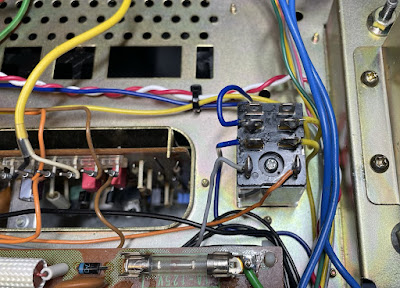




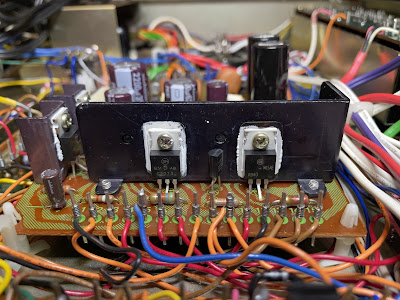
_before%20servicing.jpg)
_after%20servicing.jpg)


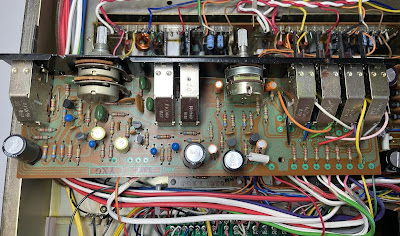
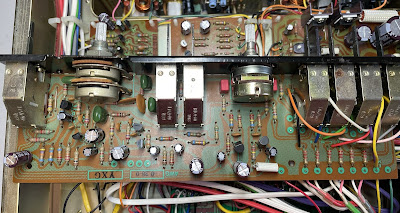


_before%20servicing.jpg)
_after%20servicing.jpg)
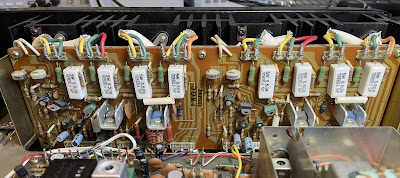

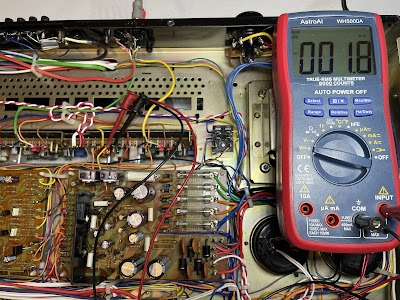
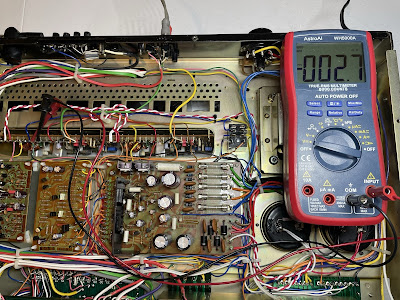





Hello Oleg, I have a Pioneer SX-1050. Brought it back with me from Okinawa back in the day. I'm having a problem with the function switches, specifically Phono-1 and -2. When I switch to Phono, I lose the left output, but if I cycle the switch once or twice I can get it to return. Does this sound like it just needs cleaning and lube? If not, any idea where I could pick up the actual switches? The schematic I have only lists 1 switch part number, ASG-095, when it's obvious there are 3 different switches on the board. BTW, I live in Park Rapids and am a retired engineer from Motorola. Thanks! Hoping you reply... Dave T
ReplyDeleteHello Dave! I bet the phono stage switch has dirty and/or oxidized contacts. This is a fairly common problem with these vintage receivers. This switch can be cleaned with a DeoxIT 5% contact cleaner, but this cannot be done without removing the front panel and the flat amplifier assembly.
DeleteHello Oleg, I sure am enjoying your restored work on all of the vintage gear. I wish that you lived closer so you could take a look at a Pioneer Spec 2 for me. I've done some work on it and the unit is my brother in law's that is paired with a Spec 1. The Spec 2 was in protect when he asked me if I could take a look at it and I did get it out of protection but the left channel will not adjust up to the 30mV..With limited skills I'm stuck. I'd ship it but it would cost a fortune because it's a heavy units There's limited technical information online anywhere that I can find.Thanks for the great video and breakdowns on restorations.
ReplyDeleteDave I am in need of a fuse that goes into the rear of my SX-950 where can I find and buy one
ReplyDeleteI believe you are talking about the primary 6A fuse (fast-acting, AGC). This fuse can be purchased in Ace Hardware, Home Depot, Lowe's, etc.
DeleteHi Oleg,
ReplyDeleteI believe my amp is an early version or perhaps they just substituted the nearest value, but I wanted to get your opinion on replacements. The following were on the board from the factory:
Flat Amp:
C25 & C26: 220 uF / 16 V (orange low leakage)
Tone Amp:
C19 & C20: 220 uF / 16 V (orange low leakage)
In the service manual and in your write-up, these are 100 uF / 10V. The rest of the circuit appears identical.
I'm going to replace with Nichicon UKL, I just want to know if you'd stick with what was on the board (220uF) or match service manual / later revisions (100 uF)?
Thanks,
Alex
There were different versions of these boards during production. I would stick with what was on the board (220uF/16V).
DeleteMuch appreciated. That's the direction I was leaning.
DeleteDo you have a specific source for replacement lighting? I have been buying replacement kits but I'm thinking of just buying some bulbs/leds in bulk and doing my own work to rewire.
I highly recommend David (dwojo69@msn.com). He has the best prices and service.
DeleteNice, thanks!
Delete